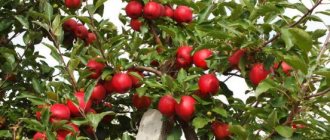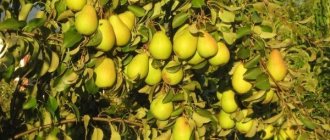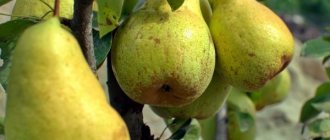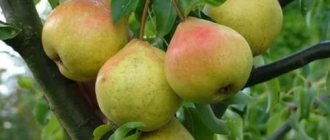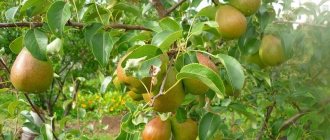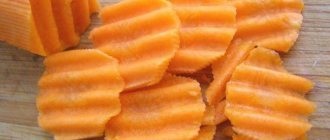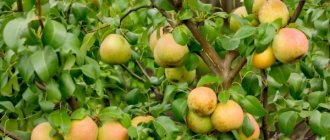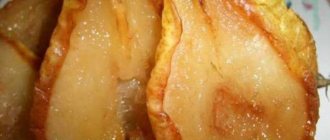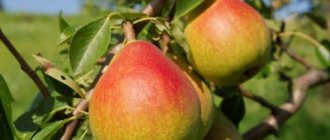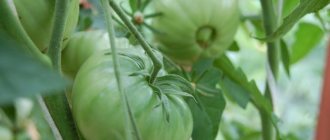Gardening » Pear
0
1355
Article rating
Kira Stoletova
The Guidon pear was named in honor of Pushkin's Prince Guidon. The variety is frost-resistant and highly fruitful. The green color of the fruit and the characteristic sour taste are the distinctive features of the Guidon variety. Let us consider in the article a detailed description of the variety.
Description of Guidon pear
Description of the variety
The Guidon pear variety was bred by Sverdlovsk breeders through open pollination of the September Fun variety. The resulting crop is characterized by good yield and resistance to diseases and pests. It is autumn ripening with many remarkable qualities.
Characteristics of wood
The tree grows quickly, but is considered low-growing, growing no higher than 3.5 meters. The crown is compact, pyramidal or round. The branches grow vertically. The shoots are thick, the leaves are dark green at the edges, but the leaves are lighter in the middle. The flowers are small, collected in inflorescences with which the entire plant is dotted.
Description of fruits
Gvidon pears.
The pears are medium-sized, weighing 120-140 grams, elongated, blunt-conical in shape, green in color with a large number of subcutaneous points; when fully ripe, they become greenish-yellow.
The pulp has a yellowish tint, is quite dense, semi-oily, the taste is sweet and sour. Tasters gave it 4.2 points out of 5 for the taste of pears.
Planting and care
Guidon pear prefers a sunny area and well-drained soil. The planting work itself is carried out in the usual manner:
- it is necessary to prepare a hole in a timely manner, where a nutrient mixture consisting of earth, ash and humus is laid;
- the seedling must be installed so that the grafted place is 6 cm above the ground level, the root system is buried with earth and compacted a little;
- the top of the tree must be cut off, leaving a seedling with a length of 0.8 - 0.9 m;
- At the end of planting, abundant watering is carried out.
Carrying out pruning
The tree will gradually grow, and one of the main points of care will be the formation of the crown by removing excess branches. If everything is done correctly, you can significantly bring the beginning of fruiting closer, and at the same time increase the yield of the tree. Almost all experienced gardeners use their own pruning methods, but there are a number of basic rules that beginners are recommended to follow:
- shoots going inside the crown are pruned;
- only the central trunk remains;
- to form the main skeleton, you need to leave multidirectional shoots of the first order in the amount of 5 pieces;
- branches of the second order are left numbering up to 7;
- to prevent excessive density of the crown, remove small branches in the required quantity;
- If there are weak and damaged shoots, they must be cut off.
Watering
The Guidon variety is fast-growing and productive, which means the tree will need large quantities of water so that it can grow and develop properly. It is impossible to get a large harvest of fruit without abundant watering. For one mature tree you will need from 10 to 15 buckets of water. If watering is done from a hose, then the sprinkler method with this variety is not recommended. Water should flow gradually into the tree trunk circle.
Landing
Proper planting of the Guidon pear variety is the key to its full fruiting. It is necessary to adhere to a number of requirements regarding the choice of location, its preparation and the acquisition of seedlings. It is also necessary not to deviate from the requirements of technology and strictly adhere to it.
You can read about all these requirements and features by following the links below.
How to plant a pear tree correctly
At what distance to plant pears?
How to choose pear seedlings
How to replant a pear
Description of pear fruits of the “Guidon” variety
"Guidon" pears reach medium and large sizes - the weight ranges from 90-110 g, some specimens grow up to 135 g. The color of the fruit is yellow, with a greenish tint, and a slight blush is often observed. The shape is classic pear-shaped, quite wide.
The pear pulp is white, medium in density and juiciness. It tastes pleasant, with pronounced sweetness, fine-grained, noticeably crunchy. Based on the results of the tasting, the Guidon variety was given the maximum mark of 5 points. The aroma is weak.
The taste sometimes suffers - it is astringent, which may be due to the weather in a particular season.
“Guidon” is a table variety; its fruits are consumed fresh. You can use them for preparations (jam, compotes, preserves). Keeping quality is low - pears do not spoil within 7-10 days - accordingly, transportability is average.
The productivity of Guidon pears reaches 50-60 kg per tree. For industrial cultivation, the figure is up to 245 c/ha. The harvests are stable and depend little on weather conditions.
Care
Agricultural technology of the Guidon variety is not difficult. The tree is unpretentious, especially does not require care, except for the standard:
- glaze;
- feeding;
- trimmings.
You can read about how to correctly carry out all the necessary procedures in the articles below.
How to care for a pear Pruning a pear Pruning a columnar pear Treating a pear from diseases and pests Feeding a pear How to water a pear
Crown formation
There are three types of removal of different parts of the tree:
- for prevention.
- for rejuvenation.
- for crown formation.
It is best to carry out crown formation in the first three years of the tree’s life. With the correct design of the crown, the result is a strong tree that can withstand the heavy weight of a large amount of harvest. Another advantage is the increase in illumination of the tree, which contributes to the long life of the pear.
To increase the speed and quantity of the harvest, you should get rid of shoots that grow inside the crown, have defects and are infected.
Diseases and pests
The variety has average winter hardiness, but is drought-resistant. Guidon pear is resistant to fungal diseases, and it also has good resistance to gall mites.
Proper prevention will help protect the tree from all diseases. You can read about it, as well as about the methods of treating Guidon pear, at the link below.
Dangerous Pear Pests
Pears often suffer from pests, they affect the leaves, bark and fruits.
In this article, we have selected 11 of the most harmful insects that harm pear trees, and also ways to destroy them.
Diseases of pear trees
To get what they cherish, gardeners have to work hard, and the reason for this is pear diseases.
Read about 19 common pear diseases and how to combat them.
Diseases
The Guidon culture is resistant to most diseases, but the danger of disease cannot be completely ruled out. To protect against various diseases and dangerous insects, there are many different insecticides (BI-58, Aktara). Bordeaux mixture will also work.
When using chemical or toxic products, remember that the fruits from this tree will be eaten by someone. Do not apply treatment during fruiting period. If the poison gets on the fruit, then for someone it can end very badly.
Planting a crop
The landing process is carried out according to a certain algorithm.
- Dig a hole. If you decide to plant a tree in the spring, then it is better to prepare it in the fall.
- Provide the tree with humus and ash. Before planting, it is worth filling the hole with these fertilizers.
- The young tree must be positioned so that the grafting site is 5 cm above the ground.
- Gently compact the soil around the seedling, but do not overdo it.
- Trim the top, leaving no more than a meter.
- After this, you need to water the tree. Do not pour water on the crown under any circumstances! Proper watering means watering the soil in the tree trunk circle with a hose.
Guidon loves light, space and requires constant watering. The future harvest depends on the successful choice of location, so the choice of planting site should be taken carefully and seriously. It's good if there is a well nearby.
In the first years after planting, it is especially important to trim excess branches and properly form the crown - this will ensure maximum tree productivity. In addition, the Guidon variety is a fast-growing variety, therefore it needs abundant watering - 10-15 buckets of water per adult tree (3-5 times per season).
The Guidon variety loves light, space and requires constant watering.
The foliage should be thick and rich in color, and the shoots should be powerful and not too long. Otherwise, nitrogen fertilization is needed. You can use urea - it is used in spring and autumn. During the period of fruit ripening (June-July), it is recommended to use mineral fertilizers. This will improve the taste of the fruit.
Reviews from gardeners
Elvir, (Sverdlovsk)
I have been gardening for a very long time and various varieties of fruit trees grow on my plot. Several winters were marked by severe frosts and some of the young trees froze very much, although this does not apply to Guidon. Despite the fact that the variety is considered to be moderately winter-hardy from cold, it was practically not damaged. Compared to Krasulya, Guidon is more resistant to cold weather. I have nothing to say about the quality of the fruit yet; the tree is very young and the first harvest is still to come. The only thing I can add is that the frost was more than -30 degrees.
Natalia, (Volchansk)
I planted the Guidon variety on the advice of my friends, and purchased a seedling from them. Timely pruning together with the formation of the crown made it possible to obtain the first harvest much earlier than planned. I was very pleased with the quantity of pears and their taste. Guidon is good for everyone, except for the safety of these same fruits. They last for about a week and then simply become unusable. We tried everything we could, even stacking pears in the cold, but no results. If we remove this shortcoming, then the variety fully meets all expectations.
IrinaA, Middle Urals
My husband is a pear lover, so we planted four of them. One of them, four years old, variety Guidon, had one pear. They didn’t let it ripen on the tree, they knocked it down with a cart in the dark, it hung low. Of course it was tough and green. It sat there for a couple of days and became quite edible. For the Urals it’s even nothing! So we will wait for some harvest next year.
Usov Sergey Yurievich, Ekaterinburg
I have been grafting and selling Guidon pears for a long time. Here I’m reading an article by Bogdanova (Director of the USSR): This year, perhaps, we will sell the new Guidon pear. What kind of a novelty is this if seedling sellers have had it on sale for a long time? This always happens. You try to work honestly - they don’t believe you, they approach a rogue who has no sign, who he is, or where he’s from - trust is overflowing.
Despite its originality, growing Guidon is completely justified. The wood's characteristics are ideal for regions with climatic conditions that are far from ideal.
Gvidon pear: description, photos, reviews
The Guidon pear was named in honor of Pushkin's Prince Guidon. The variety is frost-resistant and highly fruitful. The green color of the fruit and the characteristic sour taste are the distinctive features of the Guidon variety. Let us consider in the article a detailed description of the variety.
Description of Guidon pear
Care
Guidon loves light, space and requires constant watering. The future harvest depends on the successful choice of location, so the choice of planting site should be taken carefully and seriously. It's good if there is a well nearby.
In the first years after planting, it is especially important to trim excess branches and properly form the crown - this will ensure maximum tree productivity. In addition, the Guidon variety is a fast-growing variety, therefore it needs abundant watering - 10-15 buckets of water per adult tree (3-5 times per season).
The Guidon variety loves light, space and requires constant watering.
The foliage should be thick and rich in color, and the shoots should be powerful and not too long. Otherwise, nitrogen fertilization is needed. You can use urea - it is used in spring and autumn. During the period of fruit ripening (June-July), it is recommended to use mineral fertilizers. This will improve the taste of the fruit.
Diseases
The Guidon culture is resistant to most diseases, but the danger of disease cannot be completely ruled out. To protect against various diseases and dangerous insects, there are many different insecticides (BI-58, Aktara). Bordeaux mixture will also work.
When using chemical or toxic products, remember that the fruits from this tree will be eaten by someone. Do not apply treatment during fruiting period. If the poison gets on the fruit, then for someone it can end very badly.
2015 09 22 New varieties of pears Gardens of Russia WM9 512 Download PAL MPEG2 ARCHIVE PALWhere a pear should grow in order for it to ripen sweet and juicy fruits
Conclusion
The Guidon variety is somewhat unique and requires constant attention. It is well suited for a summer cottage or a small orchard near the house.
Source: https://FermoVed.ru/grusha/gvidon-opisanie.html
